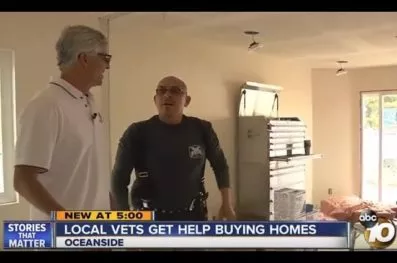Beware of a “Fixer- Upper”

Va Loans
REAL ESTATE FOR VETERANS
Buyer Beware of a “Fixer-Upper”
The pros and cons of using Your VA Home Loan Benefit to buy a house that needs some work.

Peter Van Brady
Founder of SoCal VA Homes
Author: Avoiding Mistakes & Crushing Your Deals Using Your VA Loan
As active military or as a Veteran, you have an extraordinary benefit with your VA loan. However, be cautious and plan carefully if your goal or your chosen property could be considered a “fixer-upper.” There are clear advantages and disadvantages when buying this type of home using your VA financing.
One thing we at So Cal VA Homes have learned in working with our military and Veteran community is that many military members and Veterans are “Do-it-Yourselfers.” You are skilled, independent-minded individuals who, in many cases, would rather do the work yourselves than pay someone else to improve your property. We caution you to be realistic in your expectations and your budgeting.
Ask yourself, how much work needs to be done? Can you realistically budget the cost of materials? Is there anything in the scope of the projects that you can’t do (electrical, plumbing, etc.) that you need to hire out and therefore add to the budget? The bottom line is if the property can pass the VA appraisal inspection and still get financing, you need to be acutely aware and concerned with how much time and money you’ll have to devote to the property.
You must be prepared for the financial commitments necessary to bring the scope of the renovations to their conclusion. Homeowners constantly underestimate these costs. Big projects require significant cash. What is the best way to spend your money to get the biggest bang for your buck? Do-it-yourself or “DIY” projects may appear to be the most frugal way to achieve your goals, but ultimately will the reality match up with your initial plans and expectations?
Budgeting for home improvement projects can be very difficult. In our experience, our clients are thrilled to take advantage of the 100% financing afforded by the VA loan. It’s much less common for our clients to have a significant savings account available to budget for home improvements after the home has been purchased. Financing of some sort is often needed for the next step of fixing up the home. If this is the case, what are the options for our committed do-it-yourselfers?
Financing options often only include credit cards or some type of installment loan, including those that attach liens to the new home. These options are typically offered with high rates between 9.9% and 21.9%. That is really expensive money, especially if it takes a while to pay it off. The larger the scope of the DIY projects on your new fixer-upper, the more caution we suggest you exercise. If you are planning a new kitchen, new bathroom, flooring, etc., plan on delays and additional unexpected expenses.
Another piece of advice is to not depend on home equity lines or cash-out refinances prematurely. Sometimes our clients assume that when they buy a piece of property, they can then qualify for an equity line and can pull cash out of the property relatively quickly. The reality is that most home equity line financing is available only to those who have perfect credit and have lots of equity. Banks will typically lend up to a combined loan balance of (first mortgage + equity line) 80% of the value of the property on a revolving home equity line. It will typically take years before most people build up enough equity to qualify for a home equity line of credit to finance home improvements. The same is true for a cash-out refinance, although you can likely finance up to 100% of the value of the home with a new VA loan. Still, if your purchase financing was 100%, how long to do think it will take for the property to appreciate so you can take a significant amount of cash back out?
Is it a big renovation job? Are you willing and able to commit the time and resources to complete the job in a specified time frame? Some new homeowners take years. You probably have a friend who, when you go over to their house, they're still chipping away at big projects over months and months… or even years. When you've got multiple projects going on throughout a house, the overall completion time frame tends to dramatically expand. The more you take on, the more difficult it becomes to finish the details of each project. The overall finish of the house can look piece-meal and lack continuity or a consistent feel to it.
You may want to consider hiring a professional contractor for your improvements after the purchase. Of course, the costs would be more than if it were a DIY project, but the result would likely be a finely remodeled home. When making all these decisions, factor in your time, the costs and savings and the finance charges, if you are not paying cash. Lastly consider the impact of the emotional stress on a spouse or family member related to home improvement projects. It is said that the top two reasons for divorce are family financial issues and anxiety stemming from large home improvement projects.
The other consideration might be one you don’t want to evaluate just yet. How will all this affect your resale value? You’re considering buying a “fixer,” or you’ve just bought your home, and you’re planning your remodel strategies…why think about selling? Not everyone stays in a home forever. We've got a very active database of thousands of homeowners who have used their VA benefits. Especially since active military homeowners get new orders and frequent PCS (personal change of station,) we track VA clients who are selling properties all the time. Again, be realistic. If you perform the work instead of a professional, will you be compromising the re-sale value of your home?
There are many important aspects to consider when you're thinking about buying a fixer-upper home as a do-it-yourself project. You might want to consider our Dreamweaver Home Purchase Process™ as an alternative.
If you’re unsure about all the aspects of buying a “fixer,” let SoCal VA Homes help. Call us at 949-268-7742.
As Seen on ABC 10 5:00 O’Clock News












